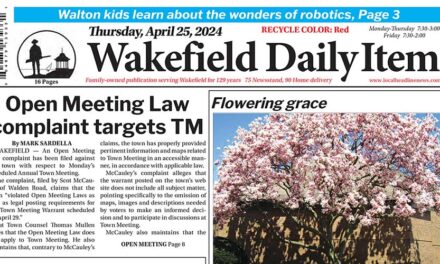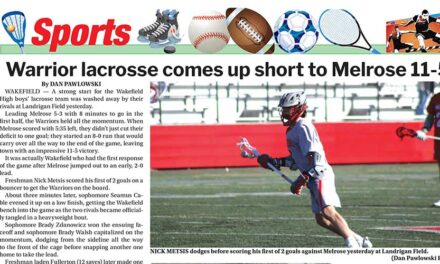By MARK SARDELLA
WAKEFIELD — The Town Council voted this week to approve Wakefield’s “Vision 2030 Statement,” but there was dissent on some of the statement’s particulars.
“Vision 2030” was a community visioning-for-planning process that the town of Wakefield embarked on to provide an opportunity for community input into developing and prioritizing community goals. Communities often undertake such visioning-for-planning processes before committing to a more comprehensive planning process (also referred to as a Master Plan). The Town of Wakefield hired the Metropolitan Area Planning Council (MAPC) to serve as public consultants and facilitators for the community brainstorming and input process.
The process included various outreach efforts, which resulted in 922 online survey responses and approximately 185-195 attendees and participants over the course of three public workshops conducted via Zoom.
The Vision 2030 Statement consists of seven bullet points summarizing the full Vision 2030 report:
We envision a Wakefield that:
• Protects and enhances its beautiful natural landscape, neighborhood character, and signature open space assets including Lake Quannapowitt, Crystal Lake, and Breakheart Reservation.
• Welcomes and supports residents in different life stages and is inviting to people of all backgrounds.
• Enhances its neighborhoods with housing options for all and safe walking and biking amenities.
• Improves its business districts with more services, leisure retail, job opportunities, and pedestrian amenities.
• Expands its social, civic, and cultural landscape with more creative placemaking amenities and more festive events.
• Invests in legacy civic projects that enhance our beautiful landscape and foster community gatherings for present-day residents and future generations.
• Reduces car dependency by leveraging its commuter rail access and other creative transportation innovations to support shops and residents.
The full Vision 2030 final report was created with guidance from MAPC. It runs over 100 pages and is available on the town’s web site.
Town Councilor Jonathan Chines, who took a lead role in the Vision 2030 project, told his fellow board members that the process wrapped up a couple of months ago. Public comment was solicited in November and the final report was released in December. Chines was seeking a vote of the Town Council to approve the Vision 2030 statement.
Town Councilor Edward Dombroski questioned several components of the statement, including the one that talks about “housing options for all.”
He said that he didn’t understand what “housing options for all” meant. He noted that Wakefield already has significant housing density for the land area it occupies. He said that the Vision 2030 report implied that residents are looking to have considerably more housing built in town.
“I don’t think we have the capacity for that,” he said.
He also cautioned that MAPC’s goals and objectives may not be the same as Wakefield’s goals and objectives. He noted that one of MAPC’s charges as an agency is to increase housing and housing density.
Chines asserted that the content in the report came, not from MAPC, but was based on feedback from local residents who participated in the public forums and responded to the surveys.
He said that the feedback received expressed a desire to preserve Wakefield’s neighborhood character but also expressed concern over people having the ability to stay in Wakefield as they age or to move into Wakefield to begin with. Affordability was an issue, Chines said, as well as the lack of available “starter homes” in town.
Chines insisted that the Vision 2030 statement was not necessarily an endorsement of the mode or style of development but rather to “make sure we have a community where people who want to live here or stay here have that ability.
Dombroski said that he was sympathetic to those needs but pointed out that making housing less expensive on the free market was not something that the town was in a position to control. He maintained that “housing options for all” was a promise that the town could not keep.
“It’s disingenuous to put that out there,” Dombroski said. “We can’t make it so everybody can live in this community.”
Town Council chair Julie Smith-Galvin disagreed, suggesting that the town does have “levers” and other ways to encourage certain kinds of housing.
Another issue that Dombroski had with the report related to transportation, specifically where it calls for the town to “reduce car dependency by leveraging its commuter rail access and other creative transportation innovations to support shops and residents.”
Dombroski insisted that this, too, was an unrealistic goal.
“We live in a suburban community,” he said, adding that the commuter rail doesn’t get most people where they need to go to do the things they need to do. On top of that, it’s expensive, he added, and not a realistic replacement for having a car.
Chines countered that there was “a lot of creativity” in the discussions and public forums, including talk of “public-private partnerships” to offer shuttle services and bike sharing services. He also said that the town could use its influence to move transportation priorities on the state level.
Town Councilor Ann Santos pointed out that it’s a vision statement and she didn’t embrace all of it.
“It’s OK to have a vision,” she said. “I don’t need to embrace everything.” Still, she said that she appreciated the ideas behind it.
Councilor Anne Danehy agreed, calling it an “aspirational” document. She said that the upcoming Master Plan process will serve as a continuation of Vision 2030.
Councilor Mehreen Butt said that the Vision 2030 Statement represents a goal. She insisted that the town does make decisions aimed at helping seniors stay in town.
She also noted that the town has two commuter rail stops and some people “reverse commute,” taking the train into Wakefield to work.
The Town Council vote to approve the Vision 2030 Statement was unanimous.




